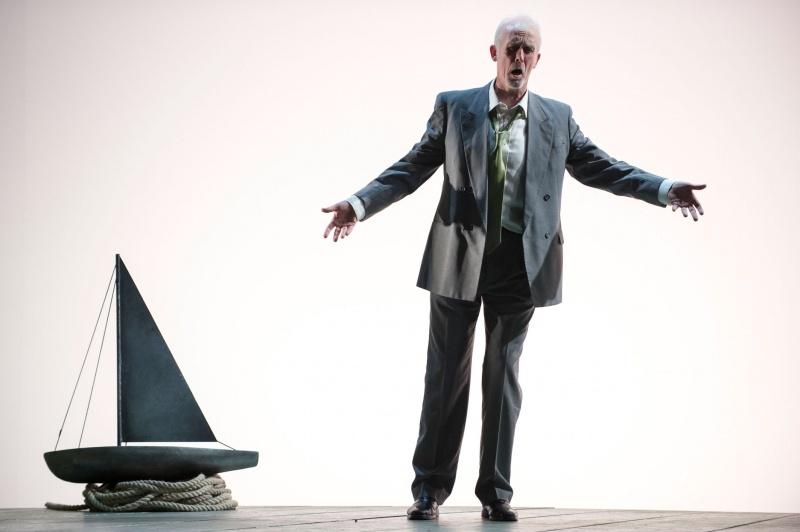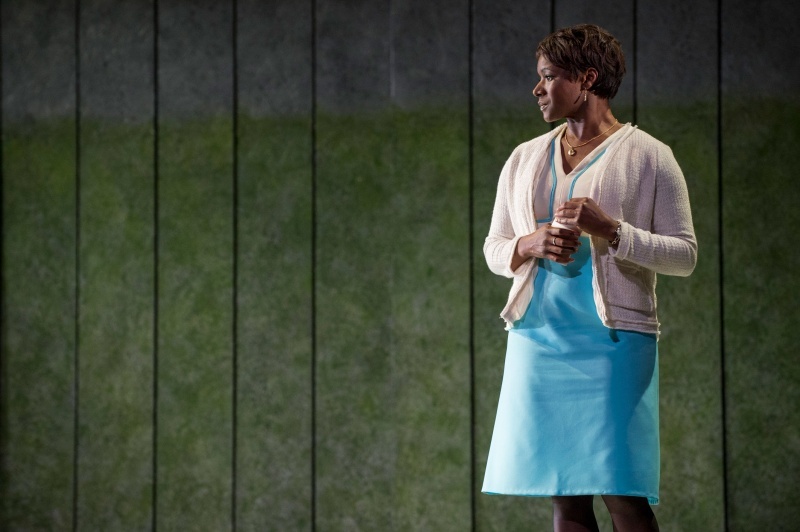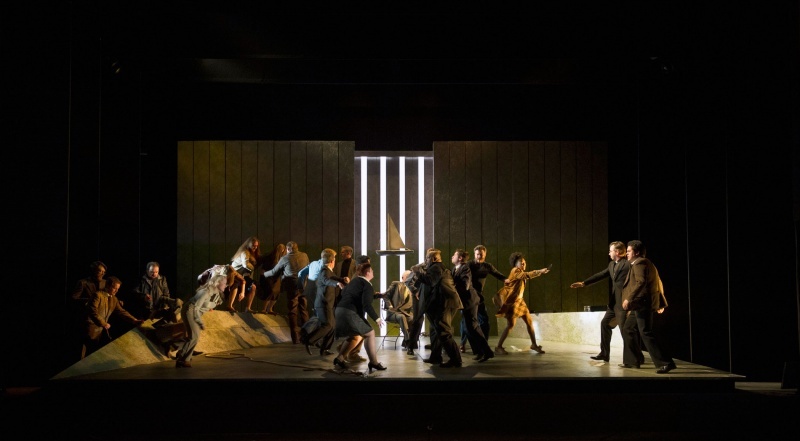Simon Boccanegra, English Touring Opera | reviews, news & interviews
Simon Boccanegra, English Touring Opera
Simon Boccanegra, English Touring Opera
A consistent and cohesive production of Verdi's problem opera

Simon Boccanegra has, as English Touring Opera’s director James Conway points out, never quite made the running outside Italy amid Verdi’s output. It went through three to five different versions in a short space of time. Despite the Romeo and Juliet era setting (14th-century Genoa battling it out with Venice) there are naivetes in Piave and Boito’s plot which, despite the frenetic story’s many merits, generate more than the usual operatic implausibilities.
Conway has had a go at sharpening the opera’s dramatic and political intensity by relocating the action of Boccanegra to modern times (just as his Donizetti The Siege of Calais seeks affinities with wartime Stalingrad). This has merits, though Boccanegra’s dottier misunderstandings or non-recognitions seem even less plausible – even ludicrous - in an age of quick communications.
There is something Lear-like about Boccanegra’s dilemmas, and his failures
The era chosen is one of appalling Italian political violence – the period of Andreotti, Togliatti and the assassinated Aldo Moro; tensions between communist-socialist left and nearly neo-Fascist right; and the ruthless two-way slaughter by the Red Brigades and their rivals (Bologna station bombing, Moro’s maimed body found in a car boot).
As an evocation of that era, from the Jonathan Miller Rigoletto-like, Mafioso-style plottings of the opening scene, it does rather well. A major asset – some might disagree violently – is the immovable pillared set, with shades of Mussolini-type architecture, by the immensely gifted Faroese born set and costume designer Samal Blak, a Linbury-prize winner with a background in sculpture (it shows) and from Central St Martins.
Once Craig Smith’s Boccanegra, after a curiously unprepossessing prologue, becomes leader, he spends a lot of time stuck on a central placed curule chair, in which he finally expires, poisoned. The effect is static, almost monolithic. And I found it wholly apt, magisterial, impressive. There is something Lear-like about Boccanegra’s dilemmas, and his failures, and the grizzled Smith (unconvincingly young at the immediate postwar outset) has an isolated look - political, familial, emotional - which Conway strives to underline.
 The fact that Smith has (unknowingly) lost, before the action starts, his wife or lover, daughter of his enemy (the always robust but now vocally magnificent Keel Watson) and then almost carelessly mislaid his baby daughter (the glorious Elizabeth Llewellyn, in a ghastly, ill-designed turquoise skirt that never changes and annoys at every turn - pictured above right), only underlines his comparable failure, or rocky efforts, to hold the creaking state, and its shifting allegiances, together.
The fact that Smith has (unknowingly) lost, before the action starts, his wife or lover, daughter of his enemy (the always robust but now vocally magnificent Keel Watson) and then almost carelessly mislaid his baby daughter (the glorious Elizabeth Llewellyn, in a ghastly, ill-designed turquoise skirt that never changes and annoys at every turn - pictured above right), only underlines his comparable failure, or rocky efforts, to hold the creaking state, and its shifting allegiances, together.
The librettists spare us Shakespearian onstage battles – no Macbeth and Macduff: revolution breaks out and then simply concludes - so we never see Boccanegra with teeth bared, sword (or Kalashnikov) in hand. Smith remains a stern, angry but strangely placid leader, accepting his end (it’s a long death) a bit like Derek Jacobi’s Claudius swallowing the poisoned mushroom.
So this is a Boccanegra you will love or ridicule. A plonky prologue is redeemed by the magnificently cast Polish bass Piotr Lempa in a small(ish) role and the Australian-born Grant Doyle. Doyle is a number one performer, as Simon’s estranged former ally Paolo, who pays with his life for a collapsed coup. The opera picks up with Act I, and the story – Conway likens it to fairy tale or fable and is in many respects right – despite its twists and turns is no more complicated than Shakespeare.
It might be interesting to view Boccanegra, for a change, as a comedy, which would ease its problems when presented as acute tragedy. With rivals reconciled, lost daughter/granddaughter/ maiden (the sensuously-voiced Llewellyn) restored, and her rebellious fiancé (the former rebel Gabriele – the edgy but increasingly impressive young Royal Academy tenor Charne Rochford) appointed Simon’s successor, the story ends happily; even if he, the old era yielding to the new, gracefully and honourably expires. Think of this Piave-Boito Genoan mini-saga more as The Comedy of Errors, with a tinge of Romeo and Juliet or Measure for Measure.
 Keel Watson’s Fiesco (Boccanegra’s enemy and, unbeknownst to him, his father-in-law), burly and lumbering but seething with emotion and justifiable outrage, is an extraordinarily touching performance, possibly the best and most intense I’ve seen Watson do to date (and he is a powerful Pizarro and pretty funny Papageno.) Rated as far away as David Pountney’s Bregenz Festival, Watson is one of the signal and significant UK operatic stage performers of our day. No matter he can look a bit stolid: this man has unique presence; a quality which to my mind Boccanegra himself also has, even though to some Smith could look merely cardboard and wimpish.
Keel Watson’s Fiesco (Boccanegra’s enemy and, unbeknownst to him, his father-in-law), burly and lumbering but seething with emotion and justifiable outrage, is an extraordinarily touching performance, possibly the best and most intense I’ve seen Watson do to date (and he is a powerful Pizarro and pretty funny Papageno.) Rated as far away as David Pountney’s Bregenz Festival, Watson is one of the signal and significant UK operatic stage performers of our day. No matter he can look a bit stolid: this man has unique presence; a quality which to my mind Boccanegra himself also has, even though to some Smith could look merely cardboard and wimpish.
All the characters, battling, disgraced or reconciled, or (in young Maria/Amelia’s case) almost comic strip-innocent, are vastly enhanced by the work of Ace McCarron, constantly employed because one of the supreme lighting designers on the circuit. Honed by engagements with two sizzling companies - Maxwell Davies’ The Fires of London and Michael McCarthy’s Music Theatre Wales - McCarron can produce the most unnerving effects with the minimum of tweaking. His lighting here worked restrained but creative wonders on Blak’s set, with its dirty beiges rising up into swathes of seaweed-green, fusing with the square-jawed Mussolinian columns.
Simon Boccanegra expires, and so does the opera, to an expressive vision of the seaport he has ruled over (a small model boat nestles backstage like some understated Aldeburgh beach-wreck), and of his beloved never-to-be bride. At that point, Blak’s imagery proved its point to perfection. This production, whatever its occasional touches of bathos, has consistency and cohesion; and that’s as important a quality in a director as anything.
Add comment
The future of Arts Journalism
You can stop theartsdesk.com closing!
We urgently need financing to survive. Our fundraising drive has thus far raised £49,000 but we need to reach £100,000 or we will be forced to close. Please contribute here: https://gofund.me/c3f6033d
And if you can forward this information to anyone who might assist, we’d be grateful.

Subscribe to theartsdesk.com
Thank you for continuing to read our work on theartsdesk.com. For unlimited access to every article in its entirety, including our archive of more than 15,000 pieces, we're asking for £5 per month or £40 per year. We feel it's a very good deal, and hope you do too.
To take a subscription now simply click here.
And if you're looking for that extra gift for a friend or family member, why not treat them to a theartsdesk.com gift subscription?
more Opera
 Cinderella/La Cenerentola, English National Opera review - the truth behind the tinsel
Appealing performances cut through hyperactive stagecraft
Cinderella/La Cenerentola, English National Opera review - the truth behind the tinsel
Appealing performances cut through hyperactive stagecraft
 Tosca, Royal Opera review - Ailyn Pérez steps in as the most vivid of divas
Jakub Hrůša’s multicoloured Puccini last night found a soprano to match
Tosca, Royal Opera review - Ailyn Pérez steps in as the most vivid of divas
Jakub Hrůša’s multicoloured Puccini last night found a soprano to match
 Tosca, Welsh National Opera review - a great company reduced to brilliance
The old warhorse made special by the basics
Tosca, Welsh National Opera review - a great company reduced to brilliance
The old warhorse made special by the basics
 BBC Proms: The Marriage of Figaro, Glyndebourne Festival review - merriment and menace
Strong Proms transfer for a robust and affecting show
BBC Proms: The Marriage of Figaro, Glyndebourne Festival review - merriment and menace
Strong Proms transfer for a robust and affecting show
 BBC Proms: Suor Angelica, LSO, Pappano review - earthly passion, heavenly grief
A Sister to remember blesses Puccini's convent tragedy
BBC Proms: Suor Angelica, LSO, Pappano review - earthly passion, heavenly grief
A Sister to remember blesses Puccini's convent tragedy
 Orpheus and Eurydice, Opera Queensland/SCO, Edinburgh International Festival 2025 review - dazzling, but distracting
Eye-popping acrobatics don’t always assist in Gluck’s quest for operatic truth
Orpheus and Eurydice, Opera Queensland/SCO, Edinburgh International Festival 2025 review - dazzling, but distracting
Eye-popping acrobatics don’t always assist in Gluck’s quest for operatic truth
 MARS, Irish National Opera review - silly space oddity with fun stretches
Cast, orchestra and production give Jennifer Walshe’s bold collage their all
MARS, Irish National Opera review - silly space oddity with fun stretches
Cast, orchestra and production give Jennifer Walshe’s bold collage their all
 Káťa Kabanová, Glyndebourne review - emotional concentration in a salle modulable
Janáček superbly done through or in spite of the symbolism
Káťa Kabanová, Glyndebourne review - emotional concentration in a salle modulable
Janáček superbly done through or in spite of the symbolism
 Buxton International Festival 2025 review - a lavish offering of smaller-scale work
Allison Cook stands out in a fascinating integrated double bill of Bernstein and Poulenc
Buxton International Festival 2025 review - a lavish offering of smaller-scale work
Allison Cook stands out in a fascinating integrated double bill of Bernstein and Poulenc
 Tosca, Clonter Opera review - beauty and integrity in miniature
Happy surprises and a convincing interpretation of Puccini for today
Tosca, Clonter Opera review - beauty and integrity in miniature
Happy surprises and a convincing interpretation of Puccini for today
 Hamlet, Buxton International Festival review - how to re-imagine re-imagined Shakespeare
Music comes first in very 19th century, very Romantic, very French operatic creation
Hamlet, Buxton International Festival review - how to re-imagine re-imagined Shakespeare
Music comes first in very 19th century, very Romantic, very French operatic creation
 Falstaff, Glyndebourne review - knockabout and nostalgia in postwar Windsor
A fat knight to remember, and snappy stagecraft, overcome some tedious waits
Falstaff, Glyndebourne review - knockabout and nostalgia in postwar Windsor
A fat knight to remember, and snappy stagecraft, overcome some tedious waits

Comments
I agree wholeheartedly with